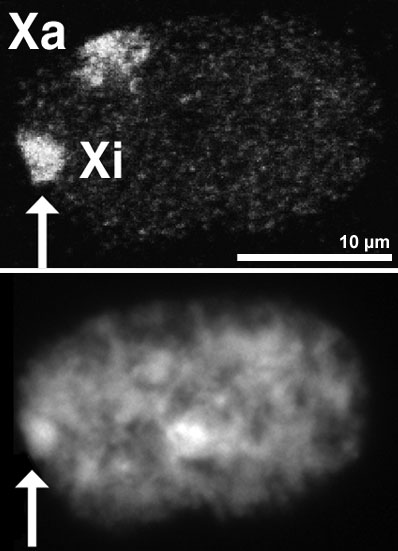X in Space (Now in 3D)
Posted by Jonathan Lawson, on 20 June 2011
![]() The 3D spatial arrangement of DNA within the nucleus is tightly controlled and has great functional significance. Each chromosome has been shown to occupy a defined nuclear territory and the expression of genes is often closely linked to where they are located, with similar expression levels seen for genes with similar locations. It has also been shown that disrupting localisation affects gene regulation.
The 3D spatial arrangement of DNA within the nucleus is tightly controlled and has great functional significance. Each chromosome has been shown to occupy a defined nuclear territory and the expression of genes is often closely linked to where they are located, with similar expression levels seen for genes with similar locations. It has also been shown that disrupting localisation affects gene regulation.
A new paper, in Genes & Development, has investigated the importance of spatial positioning in the inactivated X chromosome. The X chromosome is considerably larger than its alternative, the Y chromosome, as such males often have one copy of a gene (on the X, with no Y equivalent) whilst females have two. This disparity can cause difficulties in correct gene activity and so regulatory mechanisms are needed. In mammals, females prevent a doubling of X activity by shutting down the activity of one, generating an inactive X chromosome.

This research has shown that the gene silencing involved in X inactivation is connected to the spatial arrangement of the chromosome within the nucleus. For the active X, long stretches of DNA from different parts of the chromosome form many stable associations which are consistently maintained in different cells, with different interacting regions corresponding to active and inactive genes. However, Splinter et al. have shown that the inactive X chromosome is randomly packaged with a lack of consistent interactions.
Within the disordered inactive X conformation, the group were able to identify some genes with spatial architecture suggestive of active gene expression, these ‘escapees’ form long-range contacts with each other, similar to those seen for active genes on the active X chromosome, and other regions of the genome. These observations have effectively doubled the number of ‘escapees’ which now require further investigation.
Of the active genes identified, Xist, a non-protein coding RNA, which is known to be involved in X inactivation, is of particular interest. It has now been shown that Xist may function by affecting chromosome topology. Loss of Xist correlated strongly with a switch to the ordered, active X conformation but did not cause gene reactivation or alterations to the histone code.
Study of spatial arrangements within the nucleus has added a whole new dimension to our understanding of gene regulation. The inactive X chromosome is a particularly striking example of gene silencing, but can be a very useful tool in understanding the intricacies of these regulatory mechanisms and their impact on our lives.
Splinter E, de Wit E, Nora EP, Klous P, van de Werken HJ, Zhu Y, Kaaij LJ, van Ijcken W, Gribnau J, Heard E, & de Laat W (2011). The inactive X chromosome adopts a unique three-dimensional conformation that is dependent on Xist RNA. Genes & development PMID: 21690198


 (3 votes)
(3 votes)